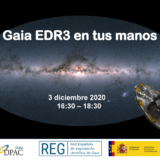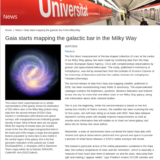Carme Jordi and Josep Manel Carrasco on “Recerclip espacial”
Recerclip espacial! “Laura Grau, Joan Oró i els misteris de l’univers” (in Catalan) https://youtu.be/5OY3TOovLRQ Video #Recerclip: Laura Grau investigates about the Joan Oró telescope at the Montsec Observatory (IEEC), with interviews to Kike Herrero (IEEC), Josep Manel Carrasco (ICCUB-IEEC), Nadia Blagorodnova (ICCUB-IEEC), Lluís Galbany (ICE-IEEC) and Carme Jordi (ICCUB-IEEC).
read moreGaia EDR3 en el Boletín de la SEA
El 21 de diciembre de 2020, fecha del solsticio de invierno, se publicó el nº 43 del Boletín electrónico de la Sociedad Española de Astronomía que incluye dos artículos sobre los nuevos datos de Gaia: Gaia EDR3: Avanzando a pasos de gigante, y Gaia: Una de escalera (de caracol) hacia el conocimiento.
read moreGaia EDR3 en tus manos
Now you can enjoy the conference Gaia, our Galaxy in your hands by our researchers, Mercè Romero and Josep Manel Carrasco that was given last Thursday, December 3rd at 19.00 via Youtube Live, the conference is in Spanish. The European Space Agency’s (ESA) Gaia satellite is revolutionizing the astronomy, providing unprecedented clues about the origin and evolution of our Galaxy, the Milky Way. Coinciding with the third publication of mission data, with more than 1.8 billion objects, we describe the mission, review Gaia’s strategy for observing the Universe, and analyse the latest...
read moreGaia EDR3 en tus manos
Coloquio-tertulia sobre los datos de Gaia-eDR3 Jueves 3 de diciembre, 16:30 a 18:30 Video del acto en YouTube Objetivos de la reunión A las 12:00 del próximo 3 de diciembre se hará pública la tercera entrega de datos de la misión Gaia, sin duda otro valioso hito esperado por la comunidad astronómica y, muy en particular, por nuestra comunidad REG. El equipo DPAC España queremos compartir, mediante este coloquio-tertulia, las lecciones aprendidas durante las fases de tratamiento de los datos y la obtención de los primeros resultados científicos publicados en los “demonstration papers”. Os...
read more582 new open clusters in the Galactic disc of our Milky Way
Alfred Castro-Ginard et al. have found 582 new open clusters, using the data from the second release of the Gaia mission. Open clusters are groups of gravitationally bound stars, that were formed in the same event – so they have the same chemical composition and age – and share a common position and proper motion. Those open clusters are fundamental objects in galaxies, and key for the understanding of the structure and evolution of the Milky Way. While young open clusters allow researchers to trace the star forming regions and to understand the star forming mechanisms, intermediate and old...
read moreGaia starts mapping the galactic bar in the Milky Way (Notícies UB, 16/07/2019)
Gaia starts mapping the galactic bar in the Milky Way (Notícies UB) The first direct measurement of the bar-shaped collection of stars at the centre of our Milky Way galaxy has been made by combining data from the Gaia mission (European Space Agency, ESA) with complementary observations by ground- and space-based telescopes. The study, published in Astronomy & Astrophysics, was led by researchers from the Institute of Science Cosmos of the University of Barcelona and from the Leibniz Institute for Astrophysics Potsdam (Germany). The second release of data from Gaia star-mapping...
read more










